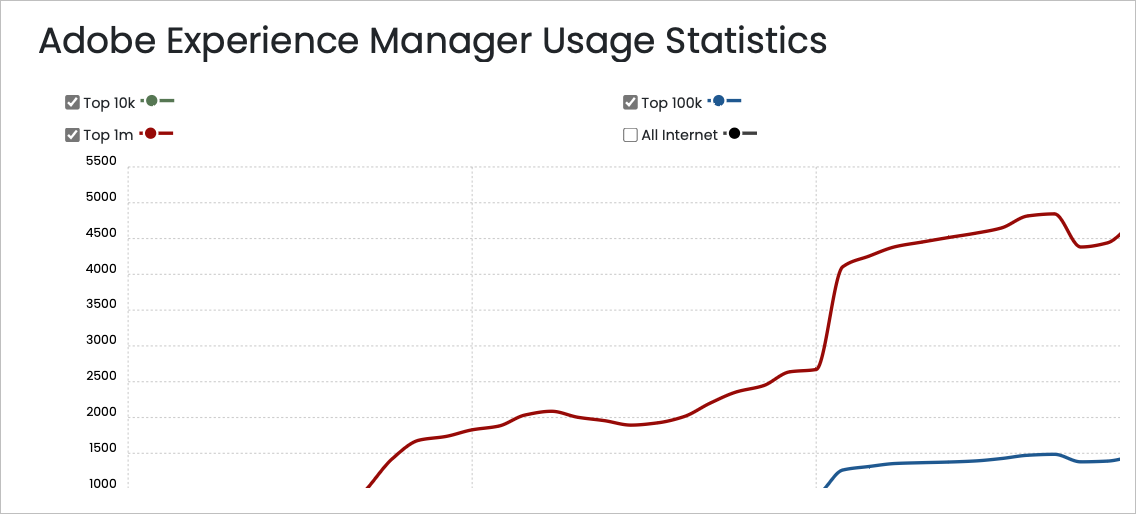What's ahead for Adobe Experience Manager? An ecosystem revolution. Here's why

The industry-leading DXP has gone from open source to market force, always leading with innovation. As the boundaries between CMS, DAM, and other creative tools dissolve, Adobe is once again transforming enterprise content management – and we’re getting a glimpse of what’s to come.
Tom Cranstoun, “The AEM Guy,” is the principal consultant at Digital Domain Technologies Limited and a CMS Critic contributor.
Adobe Experience Manager's transformation from its open source foundations to today's composable enterprise platform reveals compelling insights into where digital experience platforms are heading.
Having observed AEM implementations across global brands for thirteen years, including Nissan-Renault, Twitter, Ford, and Jaguar Land Rover, the platform's trajectory points toward a fundamental shift in how enterprises approach content management.

Graph source: builtwith.com
Beyond Traditional CMS Thinking
AEM's unique architecture – built on open-source foundations including Apache Jackrabbit, Felix, and Sling – has always enabled modular deployment. Today's 35,000 active implementations demonstrate this composability in practice, but Adobe's strategic direction suggests something far more transformative: an ecosystem approach that transcends traditional platform boundaries.
The Ecosystem Revolution
Adobe has introduced three innovations that signal this transformation: Franklin (Edge Delivery Services), the Universal Editor, and AEM Document Authoring. These aren't incremental CMS features – they represent a complete rethinking of content workflows.
- Franklin represents perhaps the most radical departure from conventional approaches. Content creators can write in Google Docs or Microsoft Word, then publish directly to Adobe's edge network as fully rendered web pages. The entire frontend becomes open source – downloadable, modifiable, and customizable without backend dependencies. This acknowledges that content creation often happens outside traditional CMS interfaces. Quick fact: Named after Rosalind Franklin, who helped discover the helix structure of DNA, the initiative aligns with Adobe's tagline of “Creativity is in our DNA.”
- The Universal Editor takes a complementary approach, enabling in-browser editing of live websites regardless of the underlying CMS. While proprietary, it can connect to any content system with appropriate markup, creating intriguing cross-platform integration possibilities.
- AEM Document Authoring (DA) bridges the gap between document-based editing simplicity and full CMS capabilities. Recent implementations demonstrate its viability – Cognizant Netcentric launched the first client website using DA for Bimota motorcycle brand in just three weeks from concept to DNS switch. DA functions as "the rocket engine accelerating Edge Delivery Services," providing enterprise-grade features like versioning, localization, and workflow management while maintaining streamlined content creation.
More significantly, Adobe positions these tools as part of a broader digital experience ecosystem rather than CMS features. The AI-powered Firefly system integrates across Photoshop, Lightroom, AEM, and Franklin through Adobe I/O – itself built on Apache OpenWhisk, an open source serverless platform. Creative professionals can save directly from Photoshop into AEM, while developers compose workflows across multiple Adobe services through standardized APIs.
Industry Transformation
This revolution carries profound implications beyond Adobe's product roadmap. Traditional boundaries between content management, digital asset management, and creative tools are dissolving. Organizations increasingly need flexible integration points rather than comprehensive suites.
The Bimota implementation exemplifies this shift. Rather than requiring months of traditional CMS setup, the motorcycle brand achieved complete digital presence in three weeks by combining document-based content creation with enterprise-grade delivery infrastructure. This speed-to-market advantage becomes particularly valuable for brands launching new products or entering new markets.
AEM's trajectory illustrates a broader industry pattern: success in enterprise software now requires balancing proprietary innovation with open standards and community contributions. Adobe maintains core differentiators while contributing to shared infrastructure that benefits the entire ecosystem.
Document Authoring's positioning between simple document editing and full CMS complexity addresses a persistent industry challenge. Many organizations struggle with tools that are either too simple for enterprise needs or too complex for content teams. DA's approach – combining familiar editing interfaces with backend enterprise features – suggests a middle path that could influence how other vendors design content creation tools.
The Path Forward
Enterprise content management appears headed toward greater modularity and specialization. Organizations will likely assemble solutions from best-of-breed components rather than selecting monolithic platforms. This creates opportunities for both established players like Adobe and emerging specialists focusing on specific workflow elements.
Adobe's investment in open-source infrastructure suggests the company understands this dynamic. By providing solid foundational technologies while competing on higher-level integration and user experience, Adobe positions itself as an ecosystem orchestrator rather than a platform vendor.
The Universal Editor's cross-platform capabilities hint at even more interesting possibilities. If content editing becomes platform-agnostic, the competitive landscape shifts from CMS features toward content workflow optimization and delivery performance.
Looking ahead, successful digital experience platforms will likely share certain characteristics: API-first architecture, headless capabilities, strong integration ecosystems, and the flexibility to work alongside rather than replace existing tools. AEM's journey provides a template for this transformation.
Why it Matters
The future belongs not to platforms that try to do everything, but to those that do specific things exceptionally well while enabling seamless integration with complementary tools. Adobe's current direction – rearchitecting while maintaining operational continuity – suggests they understand this principle and are building accordingly.
The shift from monolithic platforms to composable ecosystems represents more than a technical evolution; it's a fundamental reimagining of how enterprises create, manage, and deliver digital experiences. Adobe Experience Manager's transformation offers a glimpse into this future, where success comes from orchestrating ecosystems rather than controlling platforms.
Looking for guidance on Adobe? Talk to an expert.
Upcoming Events

CMS Connect 25
August 5-6, 2025 – Montreal, Canada
We are delighted to present the second annual summer edition of our signature global conference dedicated to the content management community! CMS Connect will be held again in beautiful Montreal, Canada, and feature a unique blend of masterclasses, insightful talks, interactive discussions, impactful learning sessions, and authentic networking opportunities. Join vendors, agencies, and customers from across our industry as we engage and collaborate around the future of content management – and hear from the top thought leaders at the only vendor-neutral, in-person conference exclusively focused on CMS. Space is limited for this event, so book your seats today.
